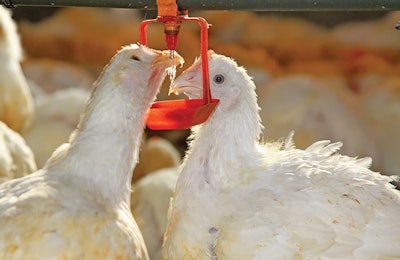
Antibiotic use decreased significantly in both the broiler and turkey industries in recent years, according to a study published in August 2019.
In an interview, Randall Singer, a co-author of the report, “Estimates of On-Farm Antimicrobial Usage in Broiler Chicken and Turkey Production in the United States, 2013 – 2017,” said the industry is showing overall improvement in antibiotic stewardship. Singer is a professor at the University of Minnesota’s College of Veterinary Medicine who has studied antimicrobial resistance in bacteria for decades.

Dr. Randall Singer, University of Minnesota | Courtesy PACCARB
The study asked the companies that form the vast majority of broiler and turkey production in the U.S. to voluntarily submit data on their antimicrobial use from 2013 to 2017. Singer was pleased with the participation. All told, between 72% and 93% of all broiler chicken produced and 77% to 82% of all turkey produced during the time period was represented in the dataset. Funding for the effort came fro the U.S. Food and Drug Administration (FDA) and from the U.S. Poultry & Egg Association.
Reduction in antibiotics usage
Singer cited one statistic, the percentage of birds receiving antimicrobials in the hatchery, as an example of the dramatic rollback. In 2013, about 93% of broiler chicks placed received antimicrobials. By the end of 2017, that figure shrunk to 17%. For turkeys, use fell to 41% from 96% during the same period.
Overall, he said, the study showed the poultry industry improved its overall stewardship of antibiotic usage by veterinarians. He noted better documentation, more discretion over use of antibiotics and a general shift away from using medically important antibiotics.
Regulations played a key role in antibiotic use. As of 2017, under the FDA's Veterinary Feed Directive (VFD), the use of medically important antibiotics for growth promotion was eliminated due to the voluntary removal of growth promotion label claims on the medically important in-feed drugs by the pharmaceutical companies. The use of these drugs now requires veterinary oversight such as a prescription for in-feed- and water-based antibiotics.
Singer said the reductions in antibiotic use began before data collection began in 2013. He said some of this shift can be attributed to the VFD, but what’s important is that the industry was able to respond to the regulatory change without sacrificing animal health, welfare and food safety.

Although the Veterinary Feed Directive’s 2017 implementation was a key factor in reduction, the roll back in antibiotic use began before that year.
Is there a limit to further reduction?
Singer expressed concern about the industry’s ability to further reduce antibiotics use without sacrificing animal health and welfare.
One class of pathogens in particular, the clostridial species that cause diseases like necrotic enteritis and gangrenous dermatitis, cannot be effectively treated without the use of antimicrobials. In order to further cut antibiotic use, he said, a new type of intervention must be found for those diseases.
Furthermore, he’s worried about the dilemma veterinarians and integrators face in either treating a sick flock or losing its premium, antibiotic-free or no-antibiotics-ever status. He said the choice should always be to treat sick animals.
“Reducing use (of antibiotics) shouldn’t be our primary goal,” Singer said. “Maintaining a healthy animal population should be our goal.”
Going forward, the industry should protect antimicrobials for both animal and human health by using them as responsibly as possible, he said.
Everyone involved in the process – growers, veterinarians and integrators – should assess the growing conditions and husbandry and consider what can be done to maximize and protect the health of the animals. When antibiotics are needed, veterinarians must ensure they are using only the right amount of the right drug for the right amount of time and nothing more.
Future research needs
Singer was pleased with the participation in the survey, but still wants more specific, granular data about which birds got antibiotics, how much they received, and how long they received those drugs.
This study reports the total amount of antimicrobial used within certain drug classes, but it doesn’t have the specific, flock-level data. He said that data was not available because this documentation was not required before 2017. An updated study should be released in 2020 and will include the granular data collected in 2017 and 2018 as well as data from the U.S. layer industry.















